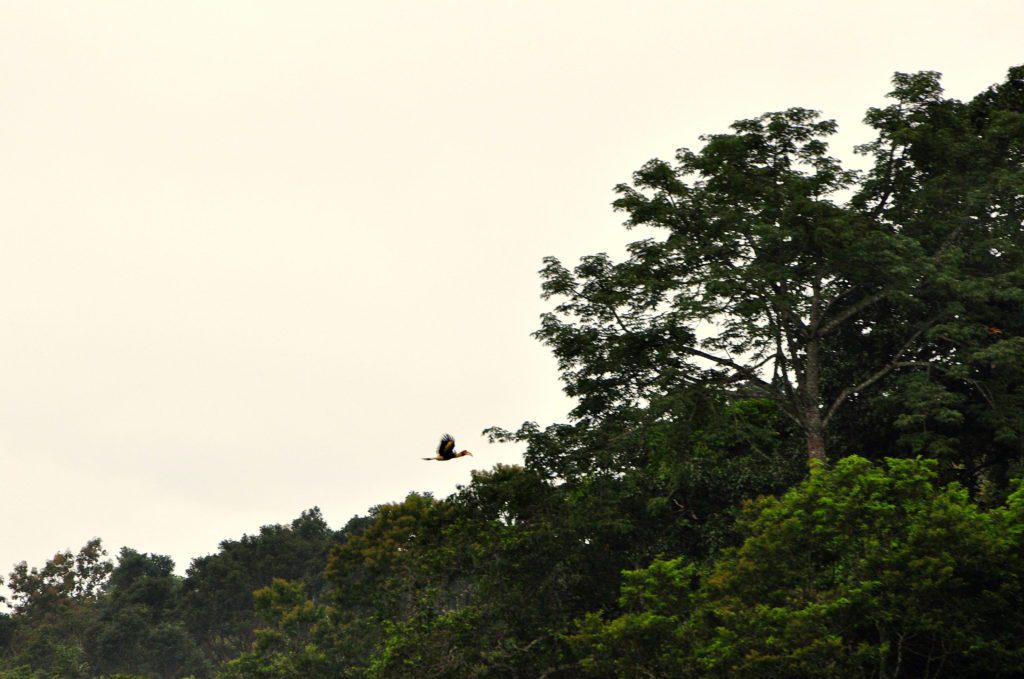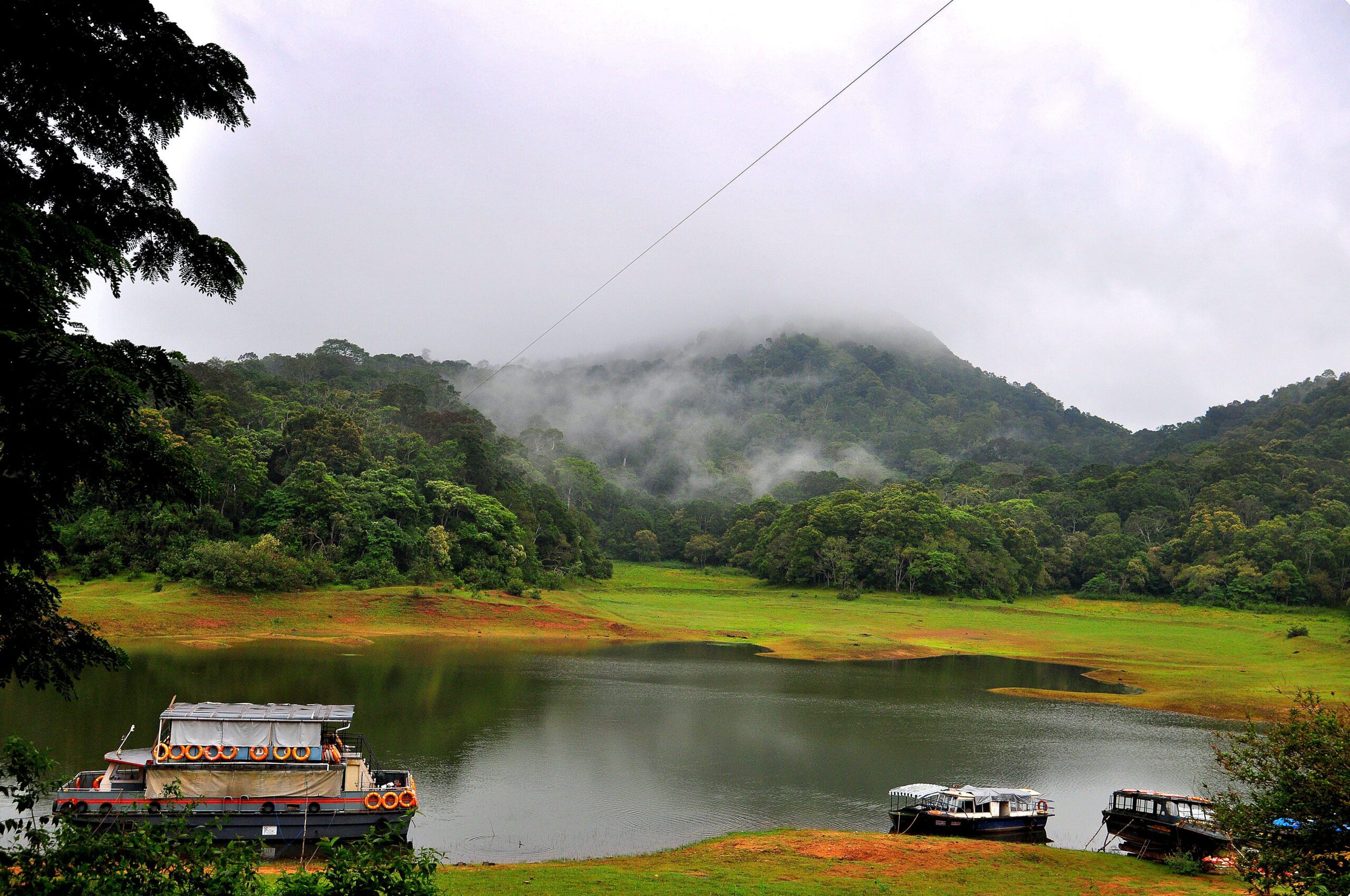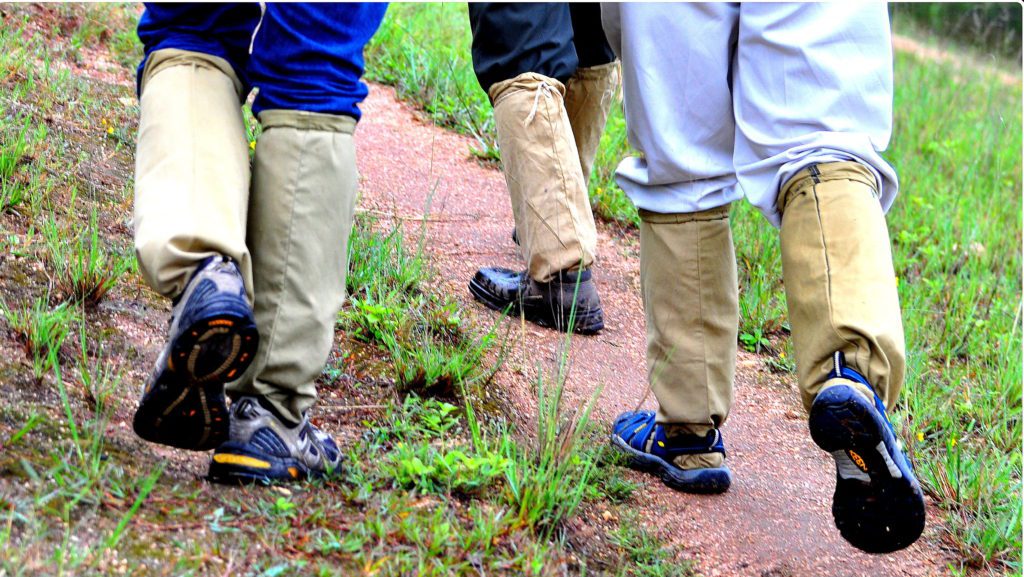Last Updated on January 17, 2021
It was 7.00 am on a crisp Thekkady morning at the Periyar Tiger Reserve.
At Periyar Tiger Reserve
There was something unrealistic about standing within 10 ft of a pack of Indian wild dogs. Popularly known as Dholes and classified as an endangered species, this elusive pack of wild canines was busy gnawing at what appeared to be the skeletal remains of a deer.
We had just embarked on our three-hour nature trek from the Periyar Tiger Reserve nature interpretation center.
Earlier, we had crossed a small creek that was part of the Periyar reservoir, standing precariously on a bamboo plank. We had just commenced our walk along the fringes of the forest when we came upon an open meadow. The Dholes were stationed here. I did the only thing I could possibly do in those circumstances – pull out my camera.
We were on the last leg of our five-day drive from Bangalore to Munnar and Thekkady. Having already covered Munnar in the last three days, we had reached Kumily the previous day and had put ourselves up at a homestay, Pepper County, owned by the lovely and enterprising couple, Mr. and Mrs. Cyriac.
Periyar Tiger Reserve is situated in the southern part of the Western Ghats spread across the Idukki, Kottayam and Pathanamthitta districts of Kerala. The reserve is also the catchment area of the river Periyar. Periyar National Park is one of the few national parks in India to remain open even during the monsoon.
We had earlier decided against the mandatory boat ride, the most common activity that tourists prefer to do when visiting the Periyar Tiger Reserve. We didn’t want to look touristy in our own home state by going on an hour and a half long boat ride with a load of other tourists ‘just to spot some wildlife’. There is no advance booking for the boat trip and there is a mad rush in the mornings to reach the booking counter and we did not want to be a part of that.
Mad rush
At 6 am we were standing behind a file of about 20 vehicles, autos, buses, taxis, and cars, before the closed gates of the Periyar Tiger Reserve – all of us patiently waiting for the gates to open. It was astonishing to realise that, at that early hour, there were so many people lined up for entry tickets. We were almost sure that most of them were here for the boat ride.
From the entry gate, one is only issued the entry ticket and a parking ticket. To get a ticket for the boat ride, you have to drive another 2 km from the entry gate, park your car and then run to the ticket counter, another 500 m from the parking lot, and join the jostling queue. It was a wet and cold morning, but tempers were definitely hot and short. Once the gate was open, there was a small rush as every car was aiming for that first spot in the queue.
Nobody was overtaking, but positively speed driving, way above the 20 km/h speed limit. We joined the mad rush till the parking lot. From the parking lot, the others continued, most of them probably boosted by the idea of having an upper deck ticket so that their chances of ‘spotting wildlife’ improved.
We had already booked a slot for the nature trek, the previous day, which was supposed to start at 7 am. As we were at least an hour early, we thought we would do a recce of the place. We first watched the excited tourists get packed onto the boat. After the boat tragedy of 2009, the authorities have limited the number of boats at the Periyar Tiger Reserve in Thekkady.
Later, we remained on the porch of the ticket counter from where one could get the best views of the reservoir. Early mornings are the best time for animal sightings as most of the wild animals come to the water. We watched a herd of Sambhar deer coming to the water and prancing around.
Nature walk at Periyar Tiger Reserve
By 6.45, we had assembled at the Nature Interpretation Center and were busy struggling with the khaki leech socks that were being provided to us by the forest department. These long leg covers, to be tied over your legwear, are supposed to protect you from poisonous insects, reptiles and the scariest ones, leeches. We were also asked to fill in forms with our contact details and the next of kin’s contact numbers and address.
The nature walk at Periyar Tiger Reserve is a light trek where every group is led by an experienced forest guide and can have up to a maximum of six individuals. The prescribed fee is Rs. 200/- per person (in 2015) but as the minimum fee for the trek was Rs. 800/- and as there were no other members in our group we had to dole out Rs. 800. It was also surprising to note that there were no other Indians in any of the other trekking groups. So much for the love of the forest!
Community-based ecotourism programmes
The Kerala Forest Department has employed local tribesmen from the Mannan community, who have a good knowledge of the local flora and fauna, as guides for the treks. The Mannan community, the oldest tribal community in the Periyar Tiger Reserve area, was primarily into fishing and cultivation. With the spread of tourism, many have now become guides. Under a program in association with the German government, they are trained to speak English, Hindi, Malayalam, Tamil, and even foreign languages like French, German and Spanish.
People-oriented and park centered community-based ecotourism is the hallmark of Periyar Tiger Reserve. These programmes are conducted by local people responsible for the surveillance of the vulnerable parts of the reserve. By taking tourists along, they are involved in the conservation of the forests of Periyar and some valuable revenue is generated for community welfare. People who once made a living by illegal operations in the forests have since become forest protectors and earn their livelihood through these programmes.
Our guide, Mr. Sasi, who had 10 years of experience, seemed to be quite knowledgeable about the jungle. After gearing ourselves with the leech socks, we started our trek. We had to cross a small creek first. It took a huge amount of practice and balance to stand still on the bamboo plank. There was the uneasiness of one’s footwear getting wet or, even worse, the dismay of plunging into the reservoir in its full glory.
Encounter with a pack of Dholes
Neither of it happened and we started walking along a forest path. Before reaching a clearing, Sasi gestured with his hand and told us not to move. He cupped his ears and told us to listen carefully.
We could hear a high-pitched whistle. We slowly walked towards the clearing and hid behind a few brittle bushes. It was then that we spotted the Dholes. There were around 7 or 8 of them, some of them busy gnawing, some of them cautiously looking around and a few of them just moving around. The Dholes must have sensed human presence as they suddenly got up and moved a bit further even as we silently pursued the pack.

Dholes are supposed to be shy and cautious animals and are found to tolerate a minimum amount of human disturbance. They are probably the only carnivores found in India which have never been accused of attacking humans. On the other hand, it is a common practice of the tribals to often steal Dhole kills, many a time right from underneath their noses!!!!
Dholes live in packs and almost look like larger dogs but with a more reddish coat and a black bushy tail. Like dogs, they are very social and communicate with each other by whistling. Dholes hunt together, teaming up to take down smaller animals like hares, rodents, pigs, and even larger preys like Sambhar deer, wild boars, and Chital. They are also quite ferocious and always end up tearing rapidly into their prey, sometimes feasting while the prey is still alive.

Sadly, the Dhole is an endangered species. As we walked further, the Dholes kept moving away from us, crossing over a patch of marshy land, half-swimming, and half-trudging and finally disappearing into the cover of the forest.
And other encounters…
Right on the side of the marshy patch was the skull of an Indian Gaur supposedly killed and eaten by a tiger about a year ago. The forest department had not removed the skull so that visitors could get to touch and feel it.
Suddenly the forest was reverberating with the unmistakably large whirring sound of the Great Malabar Hornbill. We had already seen some of its cousins in Arunachal and were quite familiar with the sounds and sights of the bird. Sasi pointed to where a hornbill nest existed and told us to wait. In less than a minute, we saw a hornbill swoop down from the skies and hop onto the tree.

Off the beaten path
We were now walking towards the forest. Throughout the three hours trek in Periyar Tiger Reserve, we learned about several different types of trees, birds, and animals. Though we were not expecting a few tigers or leopards to pose in front of us, we were quite satisfied by spotting a great variety of birds and also listening to the beautiful songs of Malabar whistling thrushes, the hoots of the coucals and the calls of the hornbills.
We also came across Nilgiri langurs and a couple of Gaurs which were grazing up on a nearby hill. The most beautiful find was the Giant Malabar Squirrel.
But what took our breath and a lot of blood away was the leeches. It is really amazing to see how these tiny creatures can jump onto one’s body like an acrobat. Also, stuck to our shoes were plenty of leeches that we constantly flicked away with twigs. At one point, Sasi sprayed some tobacco powder on our shoes which he said would keep the leeches away – not that it did. Guess our leech socks were not thick enough!

Responsible tourism
We realized that, apart from providing an opportunity to experience forest life, this trek also creates awareness in the prevention of poaching and other illegal activities like sandalwood smuggling. A lot of the night patrollers were once poachers and had been given an opportunity by the forest department to be a part of their special protection team. The plus point, of course, is that they know the forest inside out.
The most dangerous and unpredictable animals here at Periyar Tiger Reserve are sloth bears and elephants. Sasi’s brother, a night patroller, was once attacked by a sloth bear and fractured his arm and had a rod inserted. Sloth bears are at their highest alert during breeding time and when they have cubs.
Jungle stories
We also came across a huge elephant tooth, belonging to an elephant which was killed by another two years ago. In that same year, around seven other pachyderms were killed by this very elephant.
The previous day’s papers had an account of a wild elephant that had run amok in the jungle, injuring a lady. We asked Mr. Sasi about it and were surprised to hear that he was witness to the whole incident.
He had been leading a group of 6 people when the elephant came running through the jungle, catching a group of tourists unaware. In the melee that ensued, a lady fell down and fractured her leg; our guide did not even have the time to warn the tourists.
The only tiger reserve in India where night patrol is allowed
My hiker’s eyes did travel longingly to the summit of a small hill across the river. Seeing our enthusiasm, Sasi mentioned that the forest department also conducts a day and night trekking/camping program. Another interesting program is the Jungle Patrol where tourists are given an opportunity of taking part in the regular night patrolling inside the reserve. It is interesting to note that this is the only tiger reserve in the country where night patrol is allowed.

The objective of this activity is to not only explore the jungle at night but to also understand how tough the work of the forest department is. As all the forests of Tamil Nadu, Karnataka and Kerala are contiguous, sandalwood smugglers travel all the way from the other states, bare feet and barely clothed with oil applied all over, making it difficult for the patrolmen to catch them.
Another recent addition to the activities at Periyar Tiger Reserve is bamboo rafting, a full day activity which includes both hiking and rafting. Tourism is highly regulated as only 30 sq km of the park is open to tourists and trekking is only done around the buffer area. There are other activities like Border Hiking, Jungle Camp, Tribal Heritage, Tiger Trail etc. To know more click here.

Do Indians hate a walk in the jungle?
In spite of the fact that this reserve being home to a vast assortment of wildlife species, wherein a number of birds and animals are unique here, we found that most of the times these activities are only booked by foreigners. This reserve is visited by wildlife enthusiasts and nature lovers in crazy numbers, all around the year, but most of them only make it till the boat ticket counter.
Move away from the crowds. Explore nature. It is bound to leave you gasping in wonder. Step away from the usual path. It can be a rewarding experience. In every walk with nature, one receives far more than he seeks. Peace, clarity, happiness……?
Our feet were definitely happy…






















12 Comments
U spotted some amazing beauties which we dont get to see so often. The jungle path was beautiful, the Gaurs looked like Yaks from a distance..Elephant Tooth was scary and sad too…What an amazing journey u had and what a blog post! Kudos to you
It was an amazing experience to walk through the jungle and we were lucky, for at least a few hours, to breathe in some fresh air. The rest is bonus, i.e. if you get to see wild animals. You are bound to see them because it is their space. And we are the trespassers. Thank you Shilpi for the comments.
Beautifully narrated and well captured, Malini! Glad that you stayed away from the touristy boat ride. The nature trek and bamboo rafting seems quite exciting. Would love to see Periyar and Thekkady beyond the boat ride.
Thanks Niranajan. When there is so much beyond the boat ride that you can try out at Thekkady why even bother? Next time its going to be bamboo rafting and night patrolling for sure 🙂
Do they also organize a jungle safari? A drive into the jungle?
When at the reserve we did enquire about this. From what we understood they do not conduct jeep safaris. Even on their website there is no mention of a jeep safari http://www.periyartigerreserve.org/
I loved your pics. You have a good thing going here. All the best!
Thanks Vibha for the comments and for stopping by.
Just superb click.I can make it out that you enjoyed to the core.Thanks for bringing back the happy memories to us 🙂
Thank you so much Ankita. Every time I go to a reserve or sanctuary there is always something new that I learn, encounter and experience. Glad to have brought back happy memories to you 🙂
Just Wow.. Wonderful narration & Beautiful photos.
Next time, be kind enough to pull us in for such trips.
Thanks Appu/Ammu. Next time പരിഗണിക്കാം 🙂